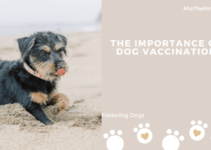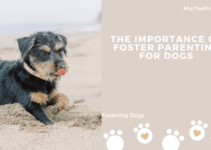Understanding Parvovirus in Dogs: A Comprehensive Guide for Fostering
Parvovirus is a highly contagious and potentially life-threatening disease that affects dogs of all ages. It is important for dog owners, especially those involved in fostering, to have a comprehensive understanding of this virus. In this guide, we will delve into the intricacies of Parvovirus, its signs and symptoms, transmission methods, diagnosis, treatment, and prevention strategies.
What is Parvovirus in Dogs?
Parvovirus, scientifically known as Canine Parvovirus (CPV), is a highly contagious viral infection that primarily affects the gastrointestinal tract of dogs. It is particularly prevalent in puppies and young dogs with weaker immune systems. The virus attacks the rapidly dividing cells in the body, causing severe damage to the intestinal lining and suppressing the immune system.
Signs and Symptoms of Parvovirus in Dogs
Recognizing the signs and symptoms of Parvovirus is crucial for early detection and prompt treatment. Dogs infected with Parvovirus often exhibit symptoms such as severe vomiting, diarrhea (often bloody), loss of appetite, lethargy, fever, and dehydration. The virus can progress rapidly, leading to life-threatening complications if left untreated.
How is Parvovirus Transmitted?
Parvovirus spreads through direct contact with infected dogs or their feces. The virus can survive in the environment for an extended period, making it highly contagious and easily transmissible. Dogs can contract Parvovirus by sniffing or licking contaminated surfaces, interacting with infected dogs, or even through indirect contact with contaminated objects such as food bowls, toys, or bedding.
Diagnosing Parvovirus in Dogs
Accurate and timely diagnosis of Parvovirus is crucial for initiating appropriate treatment. Veterinarians typically perform a combination of physical examinations, blood tests, and fecal tests to confirm the presence of the virus. Rapid diagnostic tests are often used to quickly detect the virus and determine the severity of the infection.
Treatment and Management of Parvovirus in Dogs
There is no specific cure for Parvovirus, and treatment primarily focuses on supportive care to manage the symptoms and prevent complications. Dogs infected with Parvovirus require immediate hospitalization, intravenous fluid therapy to combat dehydration, antibiotics to prevent secondary infections, anti-nausea medications, and nutritional support. Close monitoring and intensive care are essential for the best chances of recovery.
Preventing Parvovirus in Fostering Environments
Preventing Parvovirus is crucial, especially in fostering environments where dogs from different backgrounds and health statuses interact. Vaccination plays a vital role in preventing Parvovirus. Puppies should receive a series of vaccinations starting at around six to eight weeks of age, followed by regular boosters. Additionally, practicing good hygiene, such as proper disinfection of living areas, toys, and equipment, and limiting contact with potentially infected dogs, can significantly reduce the risk of transmission.
Understanding Parvovirus and its implications is essential for all dog owners, particularly those involved in fostering. By recognizing the signs, taking preventative measures, and seeking prompt veterinary care, we can effectively combat this highly contagious disease and ensure the health and well-being of our four-legged companions.
FAQs
What is Parvovirus in Dogs?
Parvovirus, scientifically known as Canine Parvovirus (CPV), is a highly contagious viral infection that primarily affects the gastrointestinal tract of dogs. It is particularly prevalent in puppies and young dogs with weaker immune systems. The virus attacks the rapidly dividing cells in the body, causing severe damage to the intestinal lining and suppressing the immune system.
Signs and Symptoms of Parvovirus in Dogs
Recognizing the signs and symptoms of Parvovirus is crucial for early detection and prompt treatment. Dogs infected with Parvovirus often exhibit symptoms such as severe vomiting, diarrhea (often bloody), loss of appetite, lethargy, fever, and dehydration. The virus can progress rapidly, leading to life-threatening complications if left untreated.
How is Parvovirus Transmitted?
Parvovirus spreads through direct contact with infected dogs or their feces. The virus can survive in the environment for an extended period, making it highly contagious and easily transmissible. Dogs can contract Parvovirus by sniffing or licking contaminated surfaces, interacting with infected dogs, or even through indirect contact with contaminated objects such as food bowls, toys, or bedding.
Diagnosing Parvovirus in Dogs
Accurate and timely diagnosis of Parvovirus is crucial for initiating appropriate treatment. Veterinarians typically perform a combination of physical examinations, blood tests, and fecal tests to confirm the presence of the virus. Rapid diagnostic tests are often used to quickly detect the virus and determine the severity of the infection.
Treatment and Management of Parvovirus in Dogs
There is no specific cure for Parvovirus, and treatment primarily focuses on supportive care to manage the symptoms and prevent complications. Dogs infected with Parvovirus require immediate hospitalization, intravenous fluid therapy to combat dehydration, antibiotics to prevent secondary infections, anti-nausea medications, and nutritional support. Close monitoring and intensive care are essential for the best chances of recovery.
Preventing Parvovirus in Fostering Environments
Preventing Parvovirus is crucial, especially in fostering environments where dogs from different backgrounds and health statuses interact. Vaccination plays a vital role in preventing Parvovirus. Puppies should receive a series of vaccinations starting at around six to eight weeks of age, followed by regular boosters. Additionally, practicing good hygiene, such as proper disinfection of living areas, toys, and equipment, and limiting contact with potentially infected dogs, can significantly reduce the risk of transmission.




